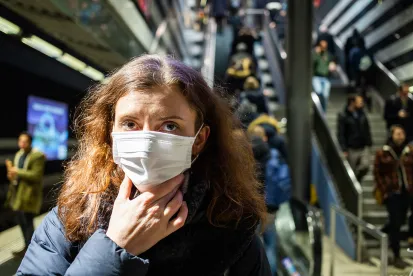As the nation debates when millions of employees should return to work despite the risk being infected with COVID-19, the grim reality of worker safety laws must be addressed. The primary law requiring a safe working environment is the Occupational Safety and Health Act (OSHA). As reported by the Washington Post, thousands of OSHA complaints are already pouring into OSHA triggered by the coronavirus pandemic. However, despite its mandate to protect worker safety, for years the OSHA whistleblower law has been highly criticized as “dysfunctional,” or worse. The time to ensure that employees can report workplace hazards, or refuse to perform life-threatening work without proper protections, is now.
Enacted in 1970, OSHA was intended to “assure so far as possible every working man and woman in the Nation safe and healthful working conditions and to preserve our human resources.” To achieve this goal Congress incorporated one of the earliest whistleblower laws into OSHA, better known as §11(c). Section 11(c) was designed to protect workers who file complaints concerning unsafe working conditions. It covers everything from an employer’s duty to ensure that a scaffolding is not dangerous to providing protective masks for hospital employees. It also prohibits retaliation against employees who raise safety concerns at work, and authorized the Secretary of Labor to file lawsuits on their behalf for reinstatement and backpay. Three years after OSHA was passed the Secretary of Labor approved regulations implementing the law. Among those rules was the right of employees to refuse to perform work, without proper safeguards, that could cause “serious injury or death.”
OSHA is the principle federal law that employees must use to report dangerous working conditions caused by the coronavirus pandemic. If their bosses require them to work in unsafe conditions that could threaten their lives, it is the OSHA law that protects their right to say “no.” In the wake of the coronavirus pandemic, forcing employees to work at risk of becoming sick with COVID-19 should be prohibited under law.
OSHA’s Hollow Promise for Workplace Safety Whistleblowers
But OSHA’s legal protections are hollow for the majority of the American workforce. Unlike all other modern whistleblower laws OSHA does not have a “private right of action.” This means that employees who suffer retaliation for reporting unsafe working conditions, or refusing to perform life threatening jobs, cannot file their own cases in court. Instead, OSHA’s §11(c) gives employee-whistleblowers the ability to file a complaint with the U.S. Department of Labor (DOL) alleging retaliation. Once filed, the fate of the whistleblower’s claim is solely in the hands of government officials, all of whom are ultimately responsible to the Secretary of Labor or President Donald Trump. Employees cannot file their own lawsuits under the OSHA law. Instead they can only file a request to OSHA to protect them. If OSHA fails to act the employee’s right to be free from retaliation cannot be enforced.
To make matters worse the OSHA law has a ridiculously short statute of limitations. Employees must file their OSHA retaliation complaint within 30-days of any adverse action. If they do not meet that extremely short deadline they automatically lose their case, regardless of how egregious the harm. This 30-day statute of limitation is among the shortest filing deadlines under any federal employment discrimination law.
A leading national expert on employee safety, Emily A. Spieler, a Professor of Law and Dean Emerita at the Northeastern University School of Law, in 2016 wrote a comprehensive analysis of OSHA for the ABA Journal of Labor & Employment Law. She summarized the “overall enforcement framework” for OSHA as “weak, underfunded, over bureaucratized and dysfunctional.” The problems with OSHA are no secret. Ten years ago the DOL’s own Deputy Assistant Secretary for Occupational Safety and Health testified before Congress that among the “weaknesses” in OSHA are the “lack of a private right of action” and the “lack of a statutory right to appeal” OSHA denials.
The statistics published by the DOL back up these findings. Even before the coronavirus pandemic whistleblowers who sought protection under OSHA were in a terrible position. For example, in FY 2019 the Labor Department issued over 2000 “determinations” in OSHA retaliation cases. It only ruled on the “merits” for whistleblowers in 14 cases. But these statistics downplay the disaster that awaits most OSHA whistleblowers. For example, Professor Spieler explained that based on three years of data she reviewed close to 1000 OSHA whistleblower cases were not even “docketed” by the Labor Department because the employee did not file his or her complaint within the 30-day statute of limitation.
In cases where OSHA reached a settlement with an employer the compensation paid to the worker was minimal. Professor Spieler reviewed the payouts obtained by employees in OSHA-settlements between 2009 and 2015. The average was only $7300. Because the employees lacked the right to file their own lawsuits, the DOL ultimately controlled the outcome of these cases, including the approval of settlements with employers.
What is most troubling in the current political environment is the power the OSHA law vests with the Secretary of Labor (and thus President Trump). Because the Secretary of Labor has the complete discretion to refuse to protect employees under OSHA, the DOL can institute practices to force employees back to work in potentially dangerous conditions, and ignore their complaints when forced to perform life-threatening work in the face of the coronavirus crisis. The Secretary of Labor has the power to refuse to support any worker who raises safety concerns regarding the coronavirus. Even if dedicated civil servants within the DOL (and there are many) want to help a worker, the ultimate authority to prosecute any §11(c) case rests on the desk of an official responsible to the Secretary of Labor and President Trump. These officials would be required to uphold any back-to-work mandates the administration deems necessary to “get the country back to work.”
OSHA’s “Right” to Refuse to Perform Life-Threatening Work
Under OSHA employees can refuse to perform work that could result in “serious injury or death.” But Labor Department rules gives wide discretion to the Secretary of Labor to interpret this “right.” Any aggressive “back to work” policy implemented by the Trump administration would radically diminish the ability of workers to protect themselves. The leeway given to the Secretary of Labor for interpreting the right of workers to refuse to perform hazardous work without proper safeguards is almost unlimited. The rule establishes a standard open to broad discretionary enforcement: “The condition causing the employee's apprehension of death or injury must be of such a nature that a reasonable person, under the circumstances . . . would conclude that there is a real danger of death or serious injury and that there is insufficient time . . . to eliminate the danger . . . In addition, in such circumstances, the employee, where possible, must also have sought from his employer, and been unable to obtain, a correction of the dangerous condition.”
Thus, the law gives the DOL the authority to determine whether or not an employee’s work refusal was “reasonable.” The Trump administration can define what is a “real danger of death or serious injury,” and whether the “correction” offered by the employer is acceptable. If the Secretary of Labor is not willing to back-up a worker, the employee has no ability to enforce his or her right to refuse hazardous work in court. Protecting workers who legitimately refuse to perform life-threatening work without proper protective gear is a decision solely within the discretion of President Trump’s Department of Labor.
If the DOL believes that an employee’s work refusal should not be protected, the DOL simply can dismiss the worker’s §11(c) complaint. The same goes to employees who blow the whistle on unsafe conditions to their bosses or regulatory authorities. The DOL can simply drop these cases. There is no appeal under federal law.
Alternatives To Federal OSHA
Currently one of the safety valves where employees can turn are state OSHA laws and progressive state court rulings. Twenty-two states have enacted their own OSHA laws that either have the same or greater protections as does the federal OSHA law. State OSHA programs are not subject to the same political pressures that the White House can bring to bear on the U.S. Department of Labor. Additionally, a growing number of state courts recognized that the federal OSHA law is deficient, and permit employees to file tort-based lawsuits if they are fired for raising health and safety concerns. The Missouri Court of Appeals explained why it was allowing workers to use state laws to protect themselves, instead of exclusively relying on federal OSHA: “OSHA only allows an employee to file a complaint with the Secretary of Labor who then decides whether to bring an action . . . the employee’s right to relief is further restricted in that the complaint must be filed within thirty days. . . . The decision to assert a cause of action is in the sole discretion of the Secretary of Labor and the statute affords the employee no appeal if the Secretary declines to file suit.”
Courts in other states have followed this logic, authorizing employees to file “public policy” lawsuits alleging wrongful discharge predicated on raising worker safety issues or refusing to perform life-threatening work. These include Alaska, California, Illinois, Iowa, Minnesota, New Mexico, New Jersey, Nevada, Ohio, and Oklahoma.
Another option is to pursue cases under some of powerful whistleblower qui tam laws that permit employees to obtain financial rewards based on providing evidence of regulatory violations or criminal violations. Most of these laws cover financial crimes, such as violations of the Dodd-Frank Act. However, the False Claims Act covers all federal contracts. If the health and safety violation also violates the terms or conditions of a federal grant, employees can use the very effective reward and anti-retaliation provisions of the False Claims Act.
There are other potential laws that can provide employee protections in the face of coronavirus contamination that may pose a harm to patients or the public, as well as the employees forced to work in dangerous conditions. Additionally, Congress has passed specific worker safety laws covering miners, truck drivers, railroad workers, seamen, and public transportation workers. None of these laws include the defective provisions that render OSHA ineffective in the majority of cases.
The Needed Reforms
The inherent weaknesses in OSHA’s §11(c)’s protections have been recognized for years. But all reform efforts have failed. In 1986-87 the President Reagan-appointed Administrative Conference of the United States unanimously recommended reforming §11(c). In a detailed report discussing OSHA, the Administrative Conference strongly endorsed creating a private right of action so employees could pursue their own cases to ensure that their OSHA rights were protected. The Administrative Conference also concluded that the statute of limitations for filing such cases needed to be enlarged from the current 30 days to at least 180 days. These recommendations fell on deaf ears. Since then there have been Congressional hearings and numerous legislative proposals to fix OSHA’s failed §11(c) procedures, but nothing has been done.
Until Congress amends the federal OSHA law, the options facing employees who blow the whistle on COVID-19 related workplace safety hazards are not good. The framework for OSHA reforms have been clearly explained as far back as 1987, when the Administrative Conference of the United States proposed modernizing OSHA §11(c), and have been reinforced continuously since then in Congressional testimony and expert reports. These reforms are very basic, would guarantee employees who are fired for reporting significant safety hazards their day in court.
Other whistleblower laws have been enacted or amended to ensure an effective private right of action. These include whistleblower laws covering airline safety, auto safety, consumer financial protection, consumer products safety, corporate accountability, food safety, safety of public transportation employees, nuclear safety, railroad safety, seaman safety, tax evasion and transportation safety (trucking industry). Significantly, in 2014 the top OSHA official in the Department of Labor urged Congress to amend the law to include the modern provisions in these numerous whistleblowers laws. The testimony of the former Assistant Secretary of Labor was clear and to the point: “To give section 11(c) the teeth it needs to be as effective as newer whistleblower statutes, it must be updated to . . . afford employees the same protections that are found in these more recent anti-retaliation statutes.”
The reforms needed to make §11(c) work as a law designed to protect workplace whistleblowers are: (1) Enlarge the statute of limitations from 30-days to 180-days; (2) create a private right of action enabling whistleblower who are subjected to retaliation to enforce their rights; (3) modernize §11(c) consistent with all of the modern whistleblower laws.
Front line health and safety workers need OSHA to be an effective law for worker safety. While they risk their health on a daily basis treating patients sick from the coronavirus pandemic, the current federal law designed to protect their safety does not work. No worker should ever be forced to choose between their job and becoming sick from COVID-19. All employees must be able to effectively enforce current workplace safety rules and blow the whistle when they witness a violation. This can only be accomplished if OSHA’s §11(c) is fixed as part of coronavirus reform legislation.




 />i
/>i

